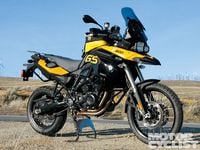BMW F800GS
Ringleader: Tim Carrithers
MSRP (2009): **$12,175
**Miles: **7870-8687
**Average Fuel Mileage: **48 mpg
**Accessories And Modifications: Touratech Desierto 3 windscreen, Pirelli Scorpion Trail tires
Despite its accommodating nature, the GS is a whole lot happier now that we've defined our relationship. After nearly 9000 miles, the oversized dirtbike that made occasional forays onto the pavement is now a comfortable, efficient tool for everything from commuting to sport-touring. But it's still not afraid to get dirty.
We spend most of our time on the road these days. Especially the rough, cratered, gravel-strewn stuff Caltrans maintenance crews and the California Highway Patrol don't care about anymore. Out there, Pirelli's Scorpion trail skins make compromise feel good. Stable and astonishingly grippy on my favorite desolate sections of twisty pavement, they're still plenty good enough for exploring local fire roads and much more confidence-inspiring than more dirt-oriented dual-sport rubber on the freeway. Expect to shell out about $115 for a 90/90VR-21 front and $143 for the 150/70VR-17 rear.
Despite my best efforts to the contrary, the GS spent 70 percent of the last 817 miles traversing various stretches of four-lane stupor-slab. I've been looking for something more substantial than BMW's potato-chip-sized windscreen for month, but nothing looked right. Then I saw the Desierto 3 ($804.70) in Touratech's 2010 catalog: a 1091-page publication capable of swallowing a rainy Saturday afternoon whole along with large sums of money.
That's Day-se-err'-to, Spanish for "desert," and while this translation isn't cheap, it is the most functional bit of wind/weather protection you can bolt to the GS. Installation can be a bit fiddly for those who tend toward speed-reading the instructions. Otherwise, complaints are nil. Developed by German industrial design house TT-3D, the third-generation of Touratech's Desierto lets you adjust the windscreen's height and angle of attack to match prevailing conditions via a pair of thumbscrews in the cockpit. After taking a little time to dial it in, said cockpit is a much nicer place, especially on nippy mornings and evenings. The tinted screen never gets in the way, even when fully extended. Air flows smoothly over and around my helmet without a hint of turbulence.
Next? Only a couple of things left on the GS to-do list: a connector to power up the PIAA driving lights on my desk, and maybe some stiffer fork springs to keep the chassis stable under hard braking. Of course that could mean a new shock as well, so let me get back to you on that one.












/cloudfront-us-east-1.images.arcpublishing.com/octane/HXOUJXQWA5HBHGRO3EMJIGFMVI.jpg)

/cloudfront-us-east-1.images.arcpublishing.com/octane/3TIWWRV4JBBOLDVGRYECVVTA7Y.jpg)
/cloudfront-us-east-1.images.arcpublishing.com/octane/KIX5O23D5NAIBGFXBN3327DKZU.jpg)
/cloudfront-us-east-1.images.arcpublishing.com/octane/7GJYDUIPXRGMTMQKN6ONYOLBOU.jpg)
/cloudfront-us-east-1.images.arcpublishing.com/octane/MUQLOVLL2ZDGFH25ILABNBXKTI.jpg)
/cloudfront-us-east-1.images.arcpublishing.com/octane/TNOU5DNE2BC57MFPMGN2EIDXAM.jpg)
/cloudfront-us-east-1.images.arcpublishing.com/octane/GTCXACQGJ5HAPDTGWUQKDEH44E.jpg)
/cloudfront-us-east-1.images.arcpublishing.com/octane/S35YGSEMEZB4BLTDJTSZPF4GLA.jpg)
/cloudfront-us-east-1.images.arcpublishing.com/octane/5UOT6HPX2JFMRJAX6EH45AR4MQ.jpg)
/cloudfront-us-east-1.images.arcpublishing.com/octane/OKWOJWAKP5EP3OACCRRWPCIX2Q.jpg)
/cloudfront-us-east-1.images.arcpublishing.com/octane/2WF3SCE3NFBQXLDNJM7KMXA45E.jpg)
/cloudfront-us-east-1.images.arcpublishing.com/octane/G4MG6OUCJNBSHIS2MVVOTPX65E.jpg)
/cloudfront-us-east-1.images.arcpublishing.com/octane/IIGGWFOTOJGB7DB6DGBXCCMTDY.jpg)
/cloudfront-us-east-1.images.arcpublishing.com/octane/QSTCM6AVEZA5JJBUXNIQ3DSOF4.jpg)
/cloudfront-us-east-1.images.arcpublishing.com/octane/U4I7G625B5DMLF2DVIJDFZVV6M.jpg)
/cloudfront-us-east-1.images.arcpublishing.com/octane/B6XD6LS6IVCQPIU6HXDJSM3FHY.jpg)
/cloudfront-us-east-1.images.arcpublishing.com/octane/ICL63FEDDRDTTMINYICCEYGMDA.jpg)
/cloudfront-us-east-1.images.arcpublishing.com/octane/FCGZHQXRBZFLBAPC5SDIQLVF4I.jpg)
/cloudfront-us-east-1.images.arcpublishing.com/octane/WNOB6LDOIFFHJKPSVIWDYUGOPM.jpg)

/cloudfront-us-east-1.images.arcpublishing.com/octane/X33NU3E525ECRHXLNUJN2FTRKI.jpg)
/cloudfront-us-east-1.images.arcpublishing.com/octane/6KKT5NNL2JAVBOXMZYS5ZO76YA.jpg)
/cloudfront-us-east-1.images.arcpublishing.com/octane/J5RKG5O455GMPGQRF2OG6LRT7A.jpg)